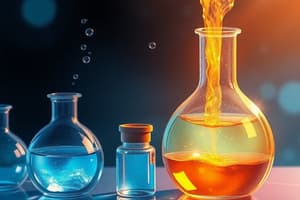Podcast
Questions and Answers
What is the process of dissolving substances called?
What is the process of dissolving substances called?
Dissolution.
What is a solute?
What is a solute?
A substance that is dissolved.
Which of the following describes miscible substances?
Which of the following describes miscible substances?
- Cannot form a solution
- Are insoluble
- Mix in any amount (correct)
- Do not mix
Oil and water are miscible substances.
Oil and water are miscible substances.
What are alloys?
What are alloys?
Match the following alloys with their components:
Match the following alloys with their components:
What is the primary gaseous component of dry air?
What is the primary gaseous component of dry air?
Which of the following statements is true about unsaturated solutions?
Which of the following statements is true about unsaturated solutions?
How does temperature affect the solubility of solids in solvents?
How does temperature affect the solubility of solids in solvents?
What is the effect of increased temperature on the solubility of gases in water?
What is the effect of increased temperature on the solubility of gases in water?
Which of the following is a component of Liquefied Petroleum Gas (LPG)?
Which of the following is a component of Liquefied Petroleum Gas (LPG)?
A supersaturated solution contains:
A supersaturated solution contains:
In a homogeneous mixture such as dry air, which gas is found in the smallest percentage?
In a homogeneous mixture such as dry air, which gas is found in the smallest percentage?
Flashcards are hidden until you start studying
Study Notes
Dissolution and Solution Formation
- Solute: A substance that dissolves in another substance. The amount of solute affects the concentration of the solution.
- Dissolution: The process of dissolving substances.
- Soluble: A substance that dissolves in a solvent.
- Insoluble: A substance that does not dissolve in a solvent.
- Miscible: Substances that mix in any amount (e.g., alcohol and water).
- Immiscible: Substances that do not mix (e.g., oil and water).
Solid Solutions - Alloys
- Alloys: Solutions of metals mixed with another element.
- Steel: iron (metal) + carbon (non-metal)
- Bronze: copper (metal) + tin (metal)
- Brass: copper (metal) + zinc (metal)
Liquid Solutions
- Liquid Solutions: Mixtures of two or more substances forming a solution.
- Vinegar: Acetic acid + water.
- Dextrose solution: Sugar + water
- Calamansi juice example: A 16g sample of calamansi juice mixed with 85g of water results in a 15.84% concentration by mass.
Concentration Calculations
- Concentration: The amount of solute in a given amount of solvent.
- Concentration calculations can involve various measurement methods.
- The text provides an example of percentage by mass calculation for Calamansi juice, a specific type of liquid solution.
- The text also provides a general example of concentration calculation involving a solute, solvent, and additional solute added to the solution.
Gaseous Solutions
- Air is a gaseous solution, a homogeneous mixture of gases.
- The primary components of air include nitrogen (78%), oxygen (20.9%), and other gases (0.17%).
- Argon makes up 0.90% of air, while carbon dioxide accounts for 0.03%.
- Dry air in the atmosphere is composed of predominantly nitrogen, oxygen, and carbon dioxide.
Liquified Petroleum Gas (LPG)
- LPG is a liquid at atmospheric pressure.
- When subjected to heat or pressure, it becomes a gas, such as when used for burning on a stove.
- LPG primarily consists of propane and butane.
Types of Solutions Based on Solute Amount
- Saturation refers to the maximum amount of solute that can dissolve in a given solvent.
- Unsaturated solutions contain less solute than the maximum solubility.
- Saturated solutions contain the maximum amount of solute that can dissolve at a given temperature and pressure.
- Supersaturated solutions contain more solute than the maximum solubility. These solutions are unstable and require additional solvent or heat to dissolve the excess solute.
Factors Affecting Solubility
- Solubility refers to the ability of a solute to dissolve in a given solvent.
- Solubility is influenced by factors such as temperature and pressure.
- The solubility of solids usually increases with higher temperatures.
- The solubility of gases in water decreases with higher temperatures.
Studying That Suits You
Use AI to generate personalized quizzes and flashcards to suit your learning preferences.




